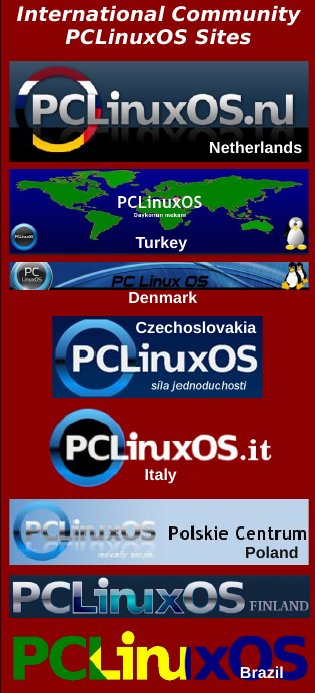| Previous
Page |
PCLinuxOS
Magazine |
PCLinuxOS |
Article List |
Disclaimer |
Next Page |
Happy 12th Birthday, PCLinuxOS! |
|
by Paul Arnote (parnote) Happy 12th Birthday, PCLinuxOS! At the young age of 12 years old, PCLinuxOS is a grandparent among Linux distributions. There are only a handful of surviving Linux distributions that have been around longer -- Red Hat, Slackware, Debian, Arch, Knoppix, Vector Linux, BLFS (Beyond Linux From Scratch) and Oracle Linux (plus a few localized versions of Linux built especially for residents of specific countries). PCLinuxOS has been around longer than Ubuntu, Mint, openSUSE, Android, Mageia, Fedora and CentOS. During the 12 year run of PCLinuxOS, many Linux distributions have come and gone. Some have seen the plug pulled, only to be reborn at a later date. The many "flavors" of Linux is what's largely responsible for its broad appeal. Linux is about choice, and with so many distributions, there are a lot of choices for Linux users. Currently, Distrowatch.com lists and tracks page hits for 278 Linux distributions. For many new Linux users coming from "one-size-fits-all" commercial operating systems, the enormous number of choices can be very overwhelming. What follows next will be a "repeat" or "rerun" for PCLinuxOS users who've been around for a while. If you're new to PCLinuxOS, you might be wondering about the origins of PCLinuxOS. If you're a PCLinuxOS veteran, few tire of hearing this story again. ***** It began on October 24, 2003. PCLinuxOS Preview .4 was released as a fork of Linux Mandrake (Mandriva) 9.2. Since that time, PCLinuxOS has matured into its own independent Linux distribution. Just uttering the all-still-too-common line that PCLinuxOS is still a fork of Mandriva may cause sparks to fly. While PCLinuxOS may have been originally forked from Mandriva, it also borrows from openSUSE, Fedora, Ubuntu, Knoppix, Mepis, Debian, Slackware, Arch and just about any/every other Linux distro around. Unlike some other Linux distros, PCLinuxOS thrives as a community distribution. It doesn't have multimillionaires and/or billionaires funneling cash into its coffers, and it doesn't have the backing of any corporation. Rather, a dedicated group of volunteers keep PCLinuxOS current by developing new programs unique to PCLinuxOS, packaging and updating the repositories, or by donating their services for various tasks that need to be done -- and that make PCLinuxOS truly unique among Linux distros. What Is PCLinuxOS? PCLinuxOS is a Linux distro, just like Ubuntu, openSUSE, Fedora, Mepis, Knoppix, Debian, Slackware, Arch and about 300 others. Probably the best way to describe PCLinuxOS is to provide a brief history from the founder of PCLinuxOS, Texstar -- a.k.a. Bill Reynolds (pictured below).  In the summer of 2003, I became interested in Live CD technology after looking at Knoppix and a fresh distribution from a fellow named Warren, called Mepis. I was interested in helping Warren with Mepis at the time, but I had no clue how to build DEB files. Coming from 5 years of packaging RPMS and not really wanting to learn a new packaging system, I happened to come across a South African fellow by the name of Jaco Greef. He was developing a script called mklivecd and porting it to Mandrake Linux. I, along with Buchanan Milne (Mandrake contributor) and a few others, began working with Jaco to help debug the scripts. I got an idea to make a livecd based on Mandrake Linux 9.2, along with all my customizations, just for fun. I had previously provided an unofficial 3rd party repository for the users of Mandrake for many years, but had since parted ways. Since Mandrake was a trademarked name, myself and others decided to name the Live CD after our news site and forum, pclinuxonline, thus PCLinuxOS. Preview .3 was my first attempt to make a livecd. I distributed it initially to about 20 people to get their reaction and feedback. Everyone who tested it loved the livecd but there was one thing missing. There wasn't a way to install the thing to the hard drive! srlinuxx from tuxmachines.org came up with a novel way to copy the livecd to the hard drive and posted it on our forums. Jaco utilized this information and inspiration from the Mepis installer and wrote a pyqt script to make the Live CD installable, thus the birth of a new distribution. On October 24, 2003, PCLinuxOS Preview .4 was released as a fork of Linux Mandrake (Mandriva) 9.2 utilizing mklivecd scripts from Jaco Greef, a multimedia kernel from Thomas Buckland (2.4.22-tmb) and a customized KDE (3.1.4-tex). Preview .5 through .93 were built upon on previous PCLinuxOS releases. After three years of updating one release from the other using the same gcc and glibc core library, we found too many programs would no longer compile or work properly against this aging code base. In November 2006, we utilized a one time source code snapshot from our friends at Mandriva to pull in an updated glibc/gcc core and associated libraries. We spent the following 6 months rebuilding, debugging, customizing, patching and updating our new code base. We pulled in stuff from our old code base, utilized patches/code from Fedora, Gentoo and Debian just to name a few. This is why you will never see me distro bashing, as it would be hypocritical to do such a thing. We are still dependent in many areas on other distros development processes due to our limited but hard working volunteer development team. On May 20th, 2007, we felt we had reached a pretty stable base and released PCLinuxOS 2007. It utilized our own kernel from Oclient1, KDE built by MDE developer Ze, updated mklivecd scripts from IKerekes & Ejtr, a heavily patched Control Center, graphics from the PCLinuxOS beautification team, and many application updates from Thac and Neverstopdreaming. Development continues as work is being done for a Minime release and an international DVD. A future release of PCLinuxOS will feature an updated kernel, KDE 4, fresh Xorg server and all the latest applications. All in all it has been a great ride and we have made many friends along the way. Some have gone on to other distributions and many are still here from our first release. As I've always said, we're just enjoying Linux technology and sharing it with friends who might like it too. We hope you have enjoyed the ride as well. While the above was written a few years ago, PCLinuxOS has continued to thrive and evolve. Shortly thereafter, MiniMe was released. MiniMe represented a barebones KDE installation, with little else than the bare desktop and core Linux OS files. Designed for more advanced users, MiniMe allows users to install only those applications that they want. Even though this distro uses the "rolling release" update method, new Live CDs were released every year (and recently, even more often) so a user wouldn't have to download a huge number of updates after installing to make sure they had the most up-to-date system available. In 2009, several developers left PCLinuxOS to start their own distro. While this happens in many other distros, PCLinuxOS hasn't suffered from it, and is still one of the top distros. In the wake of their departure, others stepped up to fill the vacated developer roles. Several other users stepped up to create the various "flavors" of PCLinuxOS. Today, there are several "flavors" of PCLinuxOS available to users, each presenting PCLinuxOS users a choice of which desktop environment to use. To this day, the KDE desktop is still employed in the "main" PCLinuxOS release. However, all of the other desktop versions utilize the exact same Linux core, as well as the same repositories. Following the rolling release design, improvements are always being made, and things evolve. First Texstar, followed by the PCLinuxOS development team, expanded their focus a bit, and a much-wished-for 64-bit edition of PCLinuxOS has recently been offered. |




